1917 - ?


|
Little Girl Blue Time Magazine Monday, Nov. 13, 1939 Chamber music is caviar to musical gourmets. Caviar from the very finest of sturgeons is the chamber music produced by the famed Budapest String Quartet, world's top-ranking string ensemble. To gobble up this treat last fortnight Manhattan's hungriest musical highbrows gathered in Town Hall to hear the first concert of the New Friends of Music's annual chamber-music series. For the occasion the Budapesters had with them two guest soloists: athletic William Primrose, world's No. 1 viola player and chief violist of Arturo Toscanini's NBC Orchestra; a small, plump, snub-nosed young woman who booped mightily through the brass coils of a big French horn. When she had finished the horn part of Mozart's Quintet in E Flat Major, with dignity she dumped the saliva from her horn, rose and went home to practice for this week's concert. The young woman's name was Ellen Stone, and playing with such topnotchers as the Budapest Quartet bothered her no whit, for she is the best woman French horn player in the world. The French horn (musicians call it simply the "horn") is far & away the hardest of all brass instruments to play. Horn-blowers must have sensitive lips as well as stout lungs. Ellen Stone first tried her lips and lungs on a French horn six years ago, in the Teaneck, N. J. high-school band, when she was 16. Says she: "After three days I wouldn't have given it up for worlds. I felt comfortable on it." By now she sounds comfortable on it, but it took some doing. She practiced from morning to nightin the garage whither her distracted family banished her. Three years later she got a scholarship from Manhattan's Philharmonic-Symphony Society. One year after that famed Conductor Otto Klemperer heard her play, and hired her to solo with the newly formed Pittsburgh Symphony. Today, 22-year-old, dark-haired Ellen Stone lives with her horn in a little bare-floored room off Manhattan's musical 57th Street. For amusement she goes to the movies, reads "great sociological novels like The Grapes of Wrath." But her big thrills come when her boy friends (mostly fellow horn players) ask her out for an evening of horn duets and trios. Her hero: sober, 180-lb., 52-year-old Bruno Jaenicke, world's champion horn player, who beeps and purls in John Barbirolli's New York Philharmonic-Symphony. Of Miss Stone's appointment to the Pittsburgh Symphony, Frédérique Petrides wrote in the October 15, 1937 issue of Women in Music:
|
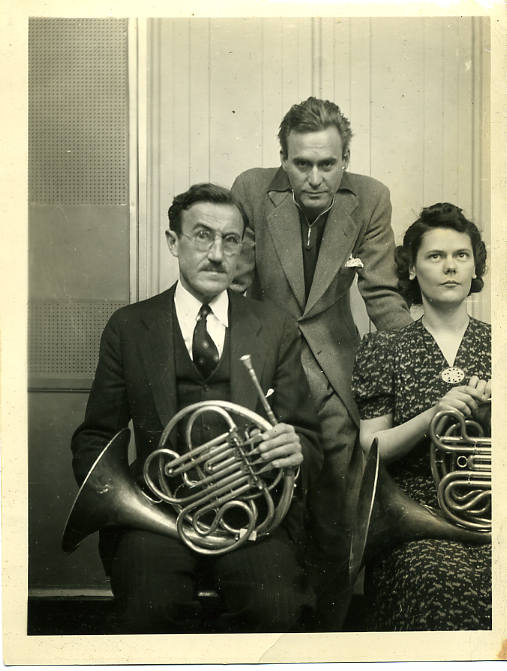
Click to see reverse side of the photo. Ellen Stone was born in 1917 in New Jersey, a daughter of Henry and Isabel Stone. Miss Stone studied with Mr. Josef Franzl and as a New York Philharmonic-Symphony Scholar with Robert Schulze of the orchestra. She also attended the Oberlin Conservatory of Music, Oberlin, Ohio. In 1935 she was featured as a soloist and as a member of the Oberlin Conservatory Ensemble on CBS radio station WHK. |
|
|
|
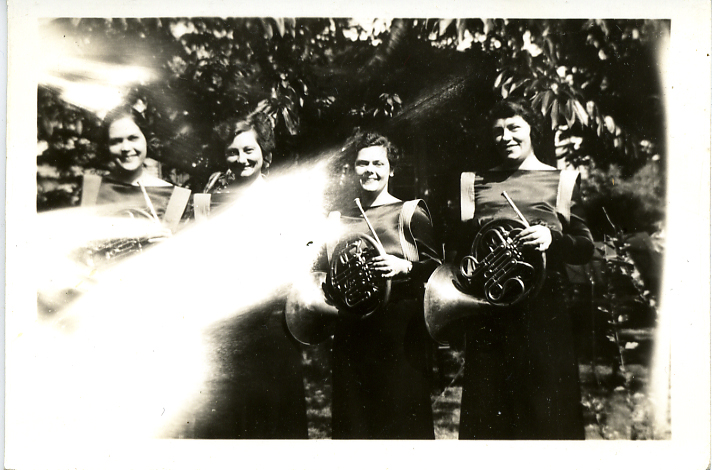
|
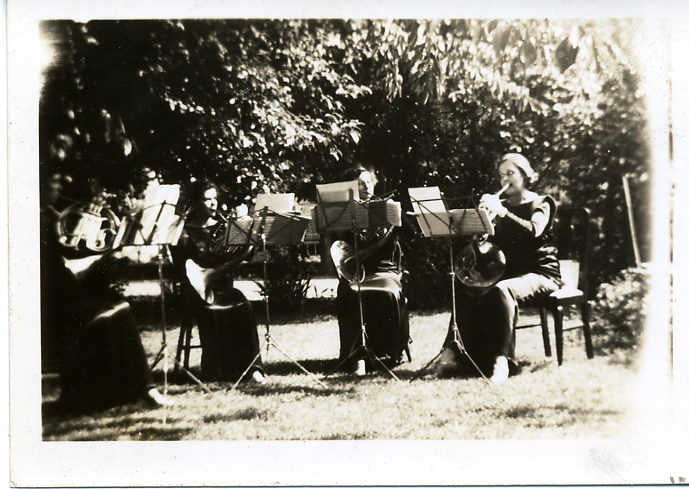
|
|
|
|
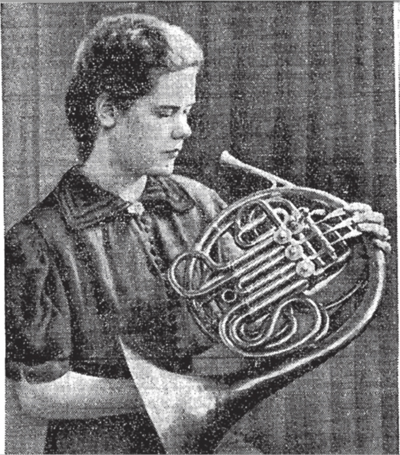
Above Miss Stone is pictured in the New York Times, October 29, 1939, for a concert the same day as soloist with the New Friends of Music primarily a professional chamber society of which she was principal horn. The program included the Horn Quintet K.V. 407 by Mozart. Of her performance that day, New York Times critic, Olin Downes had this to say: "Miss Stone is not as yet a seasoned performer. She has feeling and intelligence but her performance was calculated to indicate what might be done, rather than what was done, in point of brilliancy and variety of color by a fully developed virtuoso of her instrument." The New Friends of Music was founded by Ira Hirschmann in 1936 and presented concerts "at once substantial and unconventional" by its own artists and guests including William Primrose and the Budapest String Quartet. At right she is pictured rehearsing in the newly-formed orchestra of the New Friends of Music for its inaugural concert on October 23, 1938. The second horn is probably Philip Palmer. The first orchestra season consisted "principally of the six Brandenburg Concertos by J.S. Bach and little known or unknown symphonies of Haydn." |
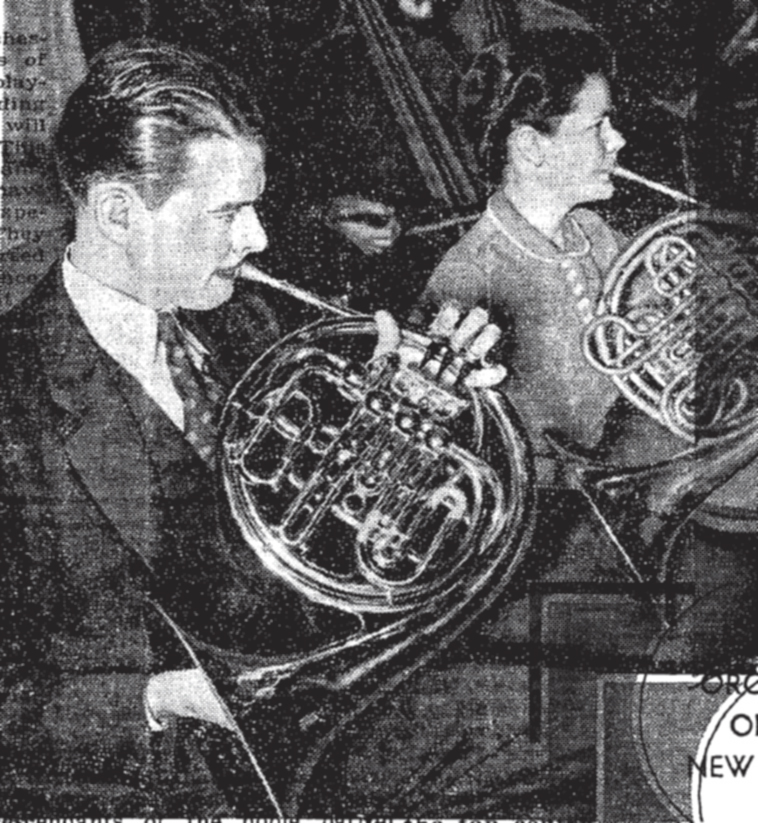
|
|
Programs featuring Ellen Stone: |
|
January 31, 1937: Under the auspices of the New York Flute Club, a quintet trained by Mr. Georges Barèrre comprising Lorna Wren, flute, Lois Wann, oboe, Ellen Stone, horn, Erika Kutzing, bassoon, and Beatrice Merlau clarinet gave its first concert in the Beethoven Association's Clubhouse. |
...In [the first] selection the orchestra's work was rather ragged, but during the remainder of the program it showed its real stride, all of the other the other numbers being given with full-bodied, resonant tone; firm rhythm, accuracy of detail and an infectious youthful exuberance.... |
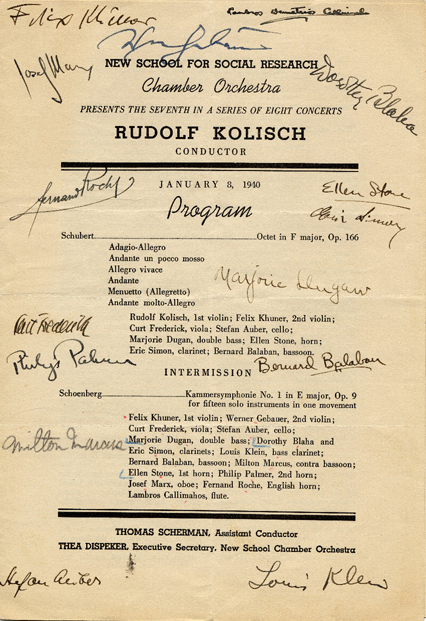
|
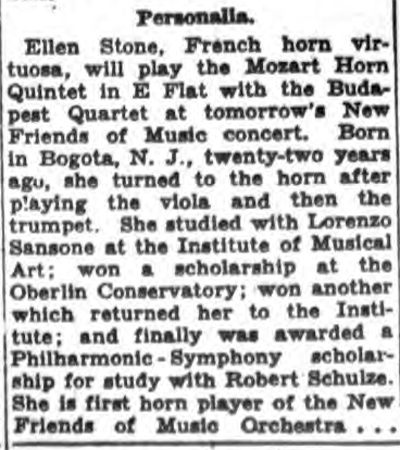 New York Times, October 28, 1939 |
Acknowledgments
The photos on this page are from the collection of Josef Franzl. Special thanks to Howard Sanner for locating the New York Times references, to Tim Johnson for identifying Macklin Morrow, and to Ms. Linnea M. Anderson, Assistant Archivist, Social Welfare History Archives, University of Minnesota Libraries. The scan of the 1940 Schubert/Schoenberg program is provided by by kind courtesy of Anthony G. Morris, CEO, AGM Digital Arts GmbH and Eike Fess, Archiv, Arnold Schönberg Center, Schwarzenbergplatz 6, A-1030, Wien.
Special thanks to Prof. George J. Ferencz for the New York Times clipping.
References
Christine Ammer, Unsung: a history of women in American music, Hal Leonard Corporation, 2001 ISBN 1574670611, 9781574670615
Jane Bowers, Judith Tick, Women Making Music: The Western Art Tradition, 1150-1950, University of Illinois Press, 1987, ISBN 0252014707, 9780252014703
Jan Bell Groh, Evening the Score / Women in Music and the Legacy of Frédérique Petrides, The University of Arkansas Press, Fayetteville, 1991
Beth Abelson Macleod, Women performing music: the emergence of American women as classical instrumentalists and conductors, McFarland, 2001, ISBN 0786409045, 9780786409044
"Little Girl Blue", Time Magazine, Nov. 13, 1939
Henry Street Music School records, Social Welfare History Archives, University of Minnesota Libraries.
"Today on the Radio", The New York Times, March 6, 1940
"Orchestral Group Gives Final Concert", The New York Times, May 3, 1937
"Positions Awarded Philharmonic Group - Major Orchestras Give Posts to Thirty-Four Students" The New York Times, April 24, 1938
"Orchestra Formed by Friends of Music", The New York Times, September 21, 1938
Olin Downes, "A New Chamber Orchestra", The New York Times, October 23, 1938
"New Friends Season Programs", The New York Times, September 10, 1939
"Opera and Concert Asides", The New York Times, October 29, 1939;
Olin Downes, "New Friends Open Fourth Year Here, The New York Times, Oct 30, 1939
"Programs of the Week", "The New York Times, November 12, 1939
"Program by New Friends", The New York Times, November 13, 1939
"Concert of New Friends", The New York Times, November 20, 1939
"Programs of the Week", The New York Times, February 4, 1940
"Notes Here and Afield", The New York Times, October, 20, 1940;
"Programs of the Week", The New York Times, October 27, 1940
"Notes Here and Afield", The New York Times, November 17, 1940;
"Week's Programs", The New York Times, December 6, 1942
"Women are Soloists as Barzin Conducts", The New York Times, March 16, 1943